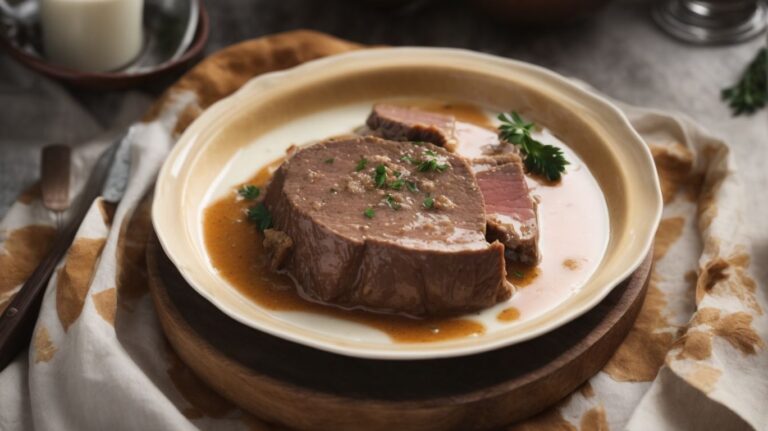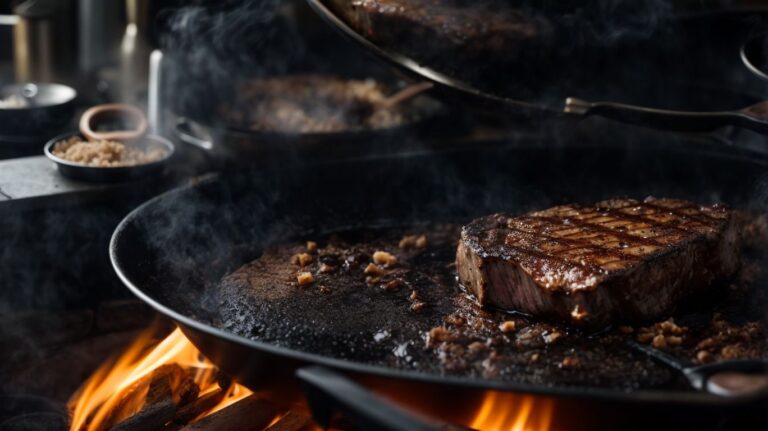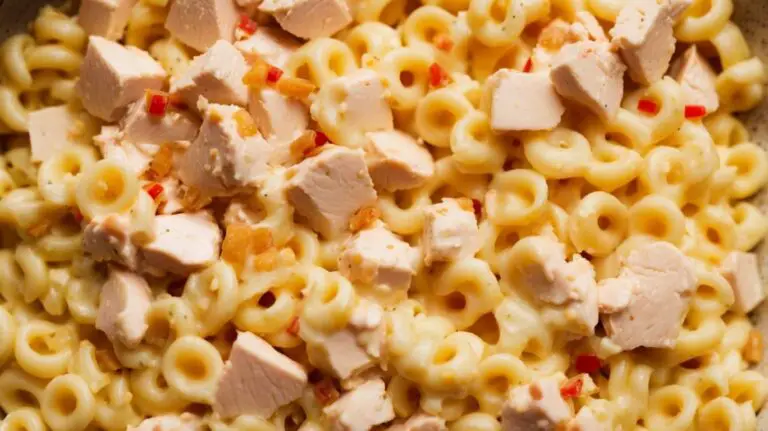How to Cook a Turkey Without a Bag?
Looking to elevate your Thanksgiving turkey game this year? Cooking a turkey without a bag is the way to go! It results in a more flavorful bird with crispy skin and gives you more control over the cooking time.
We will discuss why cooking a turkey without a bag is the way to go, what you need to get started, the steps to achieve a perfect turkey, and some tips for a successful cooking experience. Let’s get into it!
Key Takeaways:
Why Cook a Turkey Without a Bag?
Cooking a turkey without a bag offers a myriad of benefits that elevate the flavor, juiciness, and overall experience of the Thanksgiving feast. By opting for this method, you can achieve a perfectly roasted turkey that is both flavorful and tender.
This cooking technique allows the turkey’s skin to crisp up nicely, creating a mouthwatering golden-brown exterior that adds an irresistible crunch to every bite. Without the confinement of a bag, the turkey’s natural juices are free to circulate, ensuring a more succulent and moist end result.
Cooking a turkey without a bag saves you the hassle of dealing with potentially messy bag openings or concerns about bag quality affecting the flavor. It simplifies the preparation process, allowing you to focus on seasoning and basting for that perfect blend of flavors.
More Flavorful
Cooking a turkey without a bag results in a more flavorful bird, allowing the natural aromas of herbs and seasonings, such as herb butter, to permeate the meat and create a delectable taste sensation.
By opting for this method, the turkey’s skin becomes perfectly crispy, while the meat remains moist and tender. The herb butter, combined with garlic, thyme, and rosemary, infuses the turkey with a rich, savory flavor profile unmatched by bag-cooked alternatives. This technique not only enhances the taste but also adds an enticing aroma that fills the kitchen, building anticipation for the meal. Guests are greeted with a visually appealing centerpiece, showcasing golden-brown skin and juicy, flavorful meat, setting the stage for a memorable dining experience.
Crispy Skin
One of the joys of cooking a turkey without a bag is achieving a perfectly golden-brown, crispy skin that adds a delightful crunch to each bite. The process of browning the skin enhances the visual appeal and texture of the roasted bird.
When the turkey is cooked to crisp, the skin not only offers a satisfying sound as you carve into it, but also locks in the juices for flavorful and moist meat. The balance of the crispy exterior with the tender, juicy meat underneath creates a sensory experience like no other.
The act of seasoning the skin before roasting is essential in building layers of flavor that penetrate the meat, enhancing its taste with each mouthful. The blend of herbs, spices, and salt forms a crust that complements the natural flavor of the turkey.
Imagine laying out a beautifully bronzed turkey on your dining table, exuding warmth and aromas that invite everyone to gather around. The sight of a glistening, golden-brown bird instantly elevates the dining experience, making it not just a meal, but a festive feast to remember.
More Control Over Cooking Time
Cooking a turkey without a bag provides the chef with greater control over the cooking time, allowing for precise adjustments based on the desired level of doneness. Using methods like tenting ensures even cooking and optimal results.
When cooking a turkey without a bag, you can monitor the internal temperature more effectively, which is crucial for achieving the perfect doneness.
Controlling the cooking time also means that you can adjust the method to retain moisture within the meat, preventing dryness.
Tenting, a key technique in this process, involves loosely covering the turkey with foil to regulate the heat distribution and prevent the outer parts from cooking too quickly. This method helps ensure that the turkey cooks evenly, resulting in a juicy and flavorful centerpiece for your meal.
What Do You Need to Cook a Turkey Without a Bag?
To cook a turkey without a bag, essential items include a reliable roasting pan, aluminum foil for tenting, a cooking thermometer for precise temperature monitoring, and quality ingredients like Butterball turkey for optimal results.
Regarding selecting a reliable roasting pan, look for a heavy-duty stainless steel option that can withstand high cooking temperatures.
Butterball turkeys are known for their superior taste and tenderness, making them a popular choice for holiday meals.
Plus the roasting pan, having aluminum foil on hand is crucial for tenting the turkey during cooking to ensure it stays moist and evenly roasted.
A cooking thermometer is a must-have tool for accurately checking the internal temperature of the turkey to avoid under or overcooking.
Investing in these quality items will elevate your turkey cooking game and result in a delicious centerpiece for your feast.
Roasting Pan
A durable roasting pan is essential for cooking a turkey without a bag, as it collects the flavorful drippings that can be used to make delicious gravy.
With its wide and deep design, the roasting pan provides ample space to accommodate the bird, allowing for even cooking and basting. The sturdy handles on the pan make it easy to maneuver, especially when transferring the turkey in and out of the oven. The material of the roasting pan ensures uniform heat distribution, resulting in a perfectly cooked turkey with crispy skin.
Disposable roasting pans are a convenient alternative as they eliminate post-cooking cleanup hassles. Simply discard the pan after use, saving you time and effort on scrubbing and washing up. This is particularly beneficial when hosting large gatherings or holiday feasts where cleanup can become an arduous task.
Aluminum Foil
Aluminum foil is a versatile tool when cooking a turkey without a bag, allowing you to create a tented cover that preserves moisture and promotes even cooking. Ensure the turkey is properly foil-wrapped for optimal results.
When preparing to cook your turkey, aluminum foil serves as a protective barrier that helps the bird retain its natural juices, resulting in a succulent and flavorful dish. By wrapping the turkey securely in foil, you not only trap the moisture within the meat but also prevent it from evaporating too quickly, ensuring a juicy and tender outcome.
Cooking Thermometer
A reliable cooking thermometer is a crucial tool for cooking a turkey without a bag, ensuring that the bird reaches the appropriate internal temperature for safety and doneness. Proper temperature monitoring enhances the overall cooking experience.
Using a cooking thermometer takes the guesswork out of determining when your turkey is perfectly cooked, whether you prefer it juicy or well-done. Placing the thermometer in the thickest part of the bird, typically the thigh, allows you to monitor the temperature accurately throughout the cooking process.
Accurately tracking the temperature also prevents the risk of consuming undercooked poultry, which can be a breeding ground for harmful bacteria like salmonella. Consistent monitoring ensures that your turkey is not only safe to eat but also maintains its optimal flavor and texture.
Cooking Oil or Butter
Using cooking oil or butter, such as herb-infused butter, is essential for imparting rich flavors and ensuring the turkey’s moistness. Properly seasoning the bird with oil or butter enhances its preparation and overall taste.
Herb-infused butter adds an extra dimension to the turkey, infusing it with fragrant notes of rosemary, thyme, and other herbs. Not only does the butter contribute to a more succulent and flavorful meat, but it also helps to create a beautifully golden, crispy skin that is both visually appealing and delicious to bite into.
Steps to Cook a Turkey Without a Bag
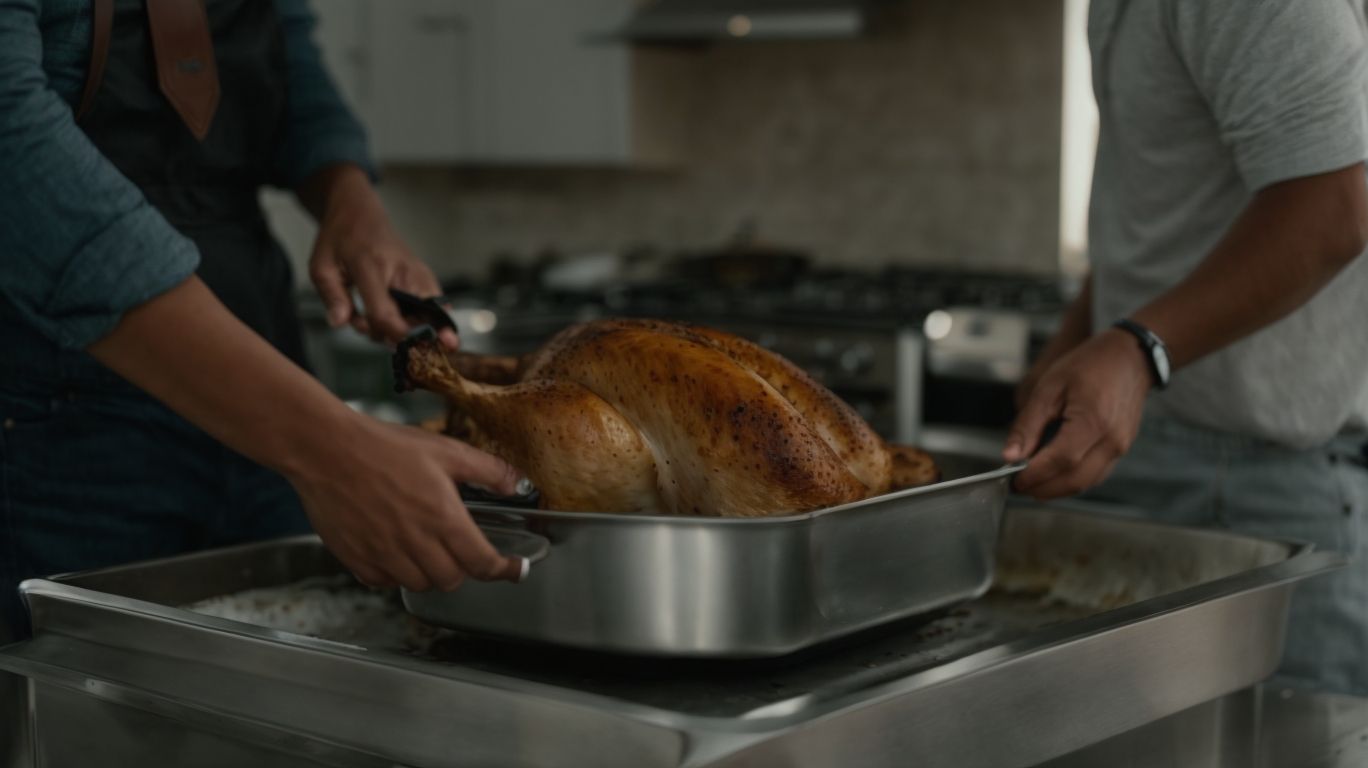
Credits: Poormet.Com – Randy Clark
Cooking a turkey without a bag involves several essential steps that ensure a moist, tender, and flavorful outcome. Following these instructions carefully will help you prepare a delicious centerpiece for your Thanksgiving feast.
First and foremost, meticulously thaw your turkey in the refrigerator allowing 24 hours for every 4-5 pounds. Once thawed, prepare a flavorful brine solution using a mix of water, salt, sugar, and aromatics. Submerge the turkey in the brine for at least 12 hours to enhance its juiciness and impart deep flavors.
When ready to cook, preheat your oven to the appropriate temperature and pat the turkey dry. Rub olive oil or melted butter generously over the skin to promote browning and lock in moisture during roasting.
Preheat the Oven
The first step in cooking a turkey without a bag is to preheat the oven to the recommended temperature, ensuring even and consistent baking. Proper oven preparation sets the foundation for a successful roasting process.
Preheating the oven before placing the turkey inside is crucial for achieving a beautifully cooked bird. When the oven is properly heated, it kick-starts the cooking process immediately and helps to seal the exterior of the turkey, locking in moisture.
Preheating also plays a significant role in ensuring that the entire turkey, from the breast to the thighs, cooks evenly. This is because a consistent temperature throughout the cooking time prevents any part of the turkey from becoming undercooked or overdone.
Prepare the Turkey
Preparing the turkey involves cleaning the cavity, seasoning with herb butter, and stuffing with aromatic vegetables to enhance the flavor profile. Proper turkey preparation sets the stage for a delicious and aromatic dish.
Regarding cleaning the cavity, a crucial step is removing any giblets or neck from the inside of the turkey. This ensures that the bird cooks evenly and prevents any unwanted flavors. Next, seasoning with herb butter adds layers of flavor and helps keep the meat moist during cooking. Rubbing the turkey with a mixture of herbs, butter, salt, and pepper not only enhances the taste but also creates a beautiful golden crust when roasted.
Another key aspect of preparing a turkey is stuffing with vegetables. Adding onions, carrots, celery, and herbs inside the cavity infuses the meat with additional flavors and aromas. These vegetables not only enhance the taste but also keep the meat moist throughout the cooking process. Paying attention to these details in turkey preparation is paramount to achieving a mouthwatering and satisfying Thanksgiving centerpiece.
Create a Flavorful Rub or Seasoning
Crafting a flavorful rub or seasoning for the turkey, such as herb-infused butter, enhances the moisture and taste of the bird. The right blend of seasonings contributes to a delectable and aromatic roasted turkey.
When creating a herb-infused butter rub for your turkey, consider using a combination of fresh herbs like rosemary, thyme, and sage for a fragrant kick. Mixing these herbs with softened butter forms a luxurious paste that not only adds flavor but also helps seal in moisture during cooking.
Incorporating seasonings like garlic powder, paprika, or a hint of cayenne pepper can elevate the overall taste profile of the turkey. These spices bring layers of complexity and warmth to the dish, making each bite a savory experience.
Place the Turkey in the Roasting Pan
After preparing the turkey, place it carefully in the roasting pan, ensuring proper positioning for even cooking. The choice of roasting pan and positioning of the bird play a crucial role in the roasting process.
When positioning the turkey in the roasting pan, ensure that it sits evenly without any parts hanging over the edges. This allows for consistent heat circulation around the bird, promoting thorough cooking. Properly positioning the turkey also helps in ensuring that the juices are distributed evenly, enhancing the flavor and moisture retention.
Choosing the right roasting pan is essential for achieving the perfect roast. A sturdy pan with low sides helps in browning the turkey evenly, while a rack inside the pan elevates the bird, allowing heat to reach all sides. The pan also collects flavorful drippings that can later be used for basting or making gravy, adding depth to the final dish.
Cook the Turkey
Cooking the turkey in the oven at the specified temperature and duration ensures that the meat remains moist, tender, and flavorful. Following the recommended cooking times is essential for a perfectly cooked bird.
When preparing your turkey for the oven, don’t forget to season it generously with your favorite herbs and spices. This not only adds delicious flavors to the meat but also enhances its overall taste. Basting the turkey throughout the cooking process helps in keeping it moist and juicy. You can use a mixture of melted butter and stock for a flavorful baste.
As the turkey roasts in the oven, monitor its internal temperature regularly with a meat thermometer. This ensures that the turkey is cooked thoroughly but not overdone, preserving its tenderness. Remember, the turkey should reach a safe internal temperature of 165°F (73.8°C) in the thickest part of the meat.
Check the Temperature
Using a cooking thermometer, check the internal temperature of the turkey to ensure it has reached the desired level of doneness for safe consumption. Monitoring the temperature is crucial for a perfectly cooked bird.
Inserting the cooking thermometer into the thickest part of the turkey’s meat without touching the bone provides an accurate reading. Different parts of the turkey may reach the safe temperature at varying times due to variations in size and thickness.
Therefore, it’s essential to check multiple spots to ensure the whole bird is thoroughly cooked.
Once the thermometer displays a temperature of 165°F (74°C), the turkey is safe to eat, juicy, and flavorful. Properly cooked turkey is not only delicious but also reduces the risk of foodborne illnesses.
Let the Turkey Rest
Allowing the turkey to rest after cooking is essential for the juices to redistribute, ensuring moist and tender meat. Tenting the bird with foil during the resting period helps retain heat and preserve the delicate flavors.
When a turkey is roasted, the heat causes the juices to move towards the surface, leaving the outer layers significantly moist. By letting the turkey rest, the redistributed juices permeate back through the meat, resulting in an evenly juicy and tender texture.
Tenting the bird with foil acts as a shield against sudden temperature drops, maintaining the warmth that is crucial for keeping the meat succulent and mouthwatering. This simple method also allows the flavors to meld harmoniously, intensifying the overall taste experience.
Tips for Cooking a Perfect Turkey Without a Bag
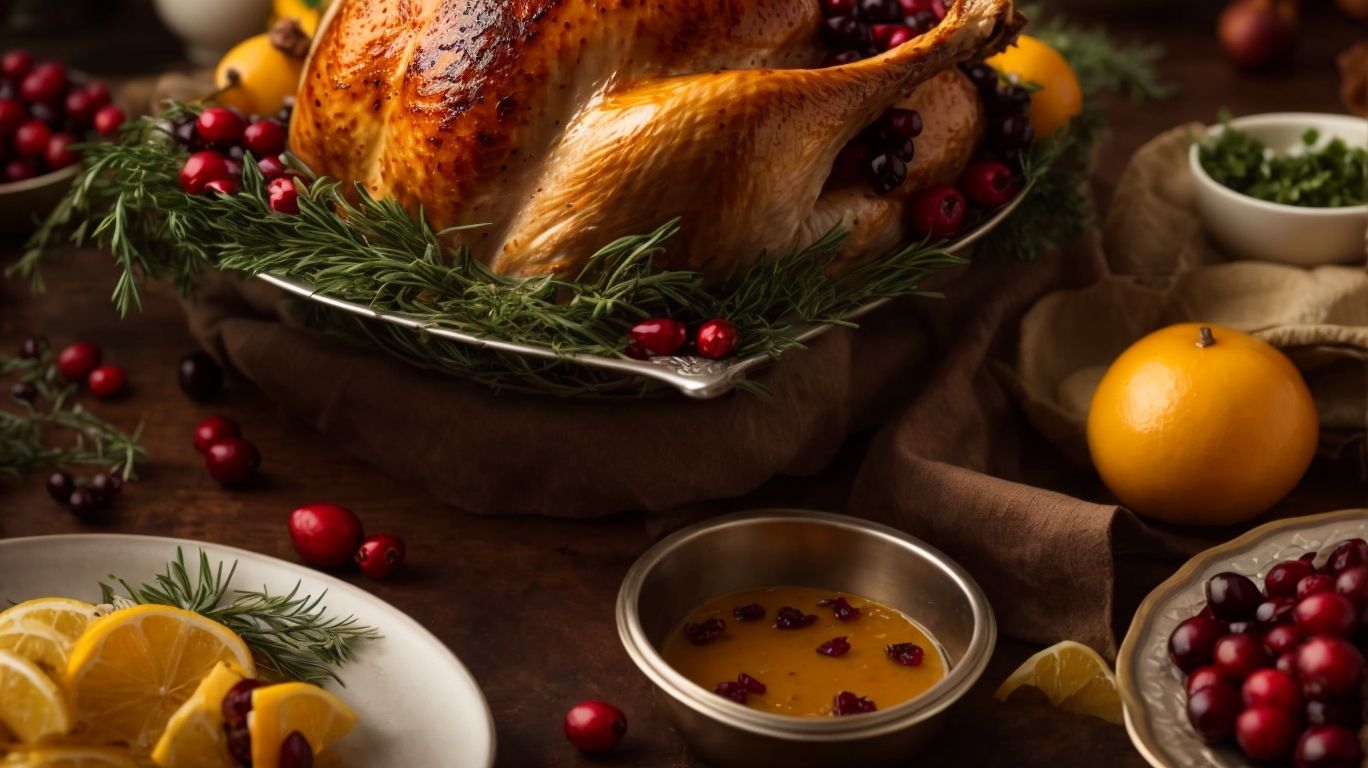
Credits: Poormet.Com – Paul Young
Achieving a perfect turkey without a bag requires attention to detail and adherence to key tips that streamline the cooking process and enhance the overall dining experience. These tips cover everything from preparation to cleanup and making the most of leftovers.
Begin by selecting a high-quality turkey, ensuring it is thawed properly if frozen. Preparing the turkey involves seasoning it generously, considering brining for added flavor, and allowing it to come to room temperature before cooking.
Regarding cooking techniques, roasting the turkey at the right temperature and monitoring it closely is crucial. After cooking, allow the turkey to rest before carving to seal in juices. Cleanup is made easier by lining the roasting pan with foil or using a disposable roasting pan. Don’t forget to save the turkey carcass for making delicious broth or soup!
Use Fresh Turkey
Opt for a fresh turkey for optimal flavor and texture, ensuring thorough thawing before cooking to promote even cooking and juiciness. Fresh ingredients are key to a delicious and memorable Thanksgiving meal.
Regarding Thanksgiving dinner, the star of the show is undoubtedly the turkey. Selecting a fresh turkey over a frozen one can make a world of difference. The plumpness of a fresh bird translates to superior taste and tenderness that is hard to replicate with a frozen alternative.
To ensure your fresh turkey shines on the dining table, proper thawing is crucial. Thawing the bird in the refrigerator at a temperature below 40°F is the safest method, allowing for a gradual thaw that helps maintain the meat’s moisture content.
Don’t Overcrowd the Pan
Avoid overcrowding the roasting pan with too many items or stuffing to allow proper air circulation and even cooking. Maintaining space around the turkey, including the cavity and vegetables, ensures optimal roasting results.
When the roasting pan is overcrowded, it can lead to uneven cooking as the heat distribution becomes compromised. By providing sufficient space around the turkey and other ingredients, you allow the hot air to circulate freely, resulting in a crispy exterior on the turkey and perfectly cooked vegetables. Adequate space also prevents steaming, ensuring that the turkey roasts instead of steams.
Baste the Turkey
Regularly basting the turkey with its own drippings or herb-infused liquids enhances moisture retention and flavor infusion during the cooking process. Basting is a time-honored method that ensures a succulent and delicious bird.
As the turkey roasts in the oven, the basting liquids act as a shield, preventing the meat from drying out and becoming tough.
This process also aids in creating a beautifully golden and crispy skin that locks in all the juices.
By basting with drippings or herb-infused liquids, you are essentially layering on additional layers of flavor, intensifying the taste and aroma of the final dish.
The act of basting allows for even cooking and temperature distribution throughout the turkey.
Each basting session is like a mini infusion of deliciousness that contributes to an exceptional dining experience.
Use a Cooking Thermometer
Utilize a cooking thermometer to monitor the turkey’s internal temperature accurately and ensure it reaches the recommended safe levels for consumption. Reliable temperature readings are essential for a perfectly cooked and safe-to-eat bird.
Using a cooking thermometer is a crucial step in the cooking process to prevent undercooking, which can lead to the risk of foodborne illnesses due to harmful bacteria. Insert the thermometer into the thickest part of the turkey without touching the bone for the most accurate reading. Different parts of the turkey may cook at varying rates, so checking multiple spots ensures uniform doneness.
When the thermometer reaches the optimal internal temperature recommended by food safety guidelines, typically around 165°F (74°C) for poultry, the turkey is safe to consume. Remember to let the turkey rest for a few minutes before carving to allow the juices to redistribute, resulting in a moist and flavorful bird.
Let the Turkey Rest Before Carving
Allow the turkey to rest for a sufficient period before carving to retain juices and maximize tenderness. Tenting the bird with foil during the resting phase preserves heat and juices, resulting in a succulent and enjoyable dining experience.
When you give the turkey this time to rest, the juices redistribute throughout the meat, ensuring each slice is moist and flavorful. This crucial step also allows the proteins to relax, making the meat more tender and easier to carve. Tenting the turkey with foil acts as a protective shield, keeping the heat trapped around the bird and preventing moisture loss. By creating this warm and cozy environment, you lock in all the delicious flavors and natural juices, guaranteeing a delicious and satisfying meal for all your guests.
Frequently Asked Questions
How to Cook a Turkey Without a Bag?
1. Do I need a cooking bag to cook a turkey?
No, a cooking bag is not necessary to cook a turkey. There are other methods that can yield just as delicious results.
2. What are the benefits of cooking a turkey without a bag?
Cooking a turkey without a bag allows for better browning and crisping of the skin. It also allows for more flexibility in seasoning and flavoring the turkey.
3. How do I prepare the turkey for cooking without a bag?
First, make sure to remove the giblets from the turkey and pat it dry with paper towels. Then, rub the turkey with a mixture of herbs and spices for added flavor.
4. Can I use a roasting pan to cook a turkey without a bag?
Yes, a roasting pan is a great alternative to a cooking bag. Just make sure to line the pan with foil for easier cleanup.
5. What temperature should I cook the turkey at?
For a turkey without a bag, it is recommended to cook it at a higher temperature (around 375°F) for a shorter amount of time to ensure a crispy skin and juicy meat.
6. How do I know when the turkey is fully cooked?
The best way to determine if a turkey is fully cooked is by using a meat thermometer. Insert the thermometer into the thickest part of the turkey (usually the thigh) and when it reaches 165°F, the turkey is ready to be taken out of the oven.


